SHOT TO REMEMBER
By Rob Feld
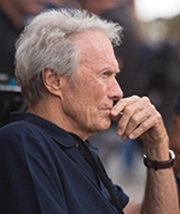 Come the penultimate scene of Clint Eastwood's masterpiece Western, Unforgiven, it's all over but the shootout. Reformed renegade killer William Munny (Eastwood) has come out of retirement to earn money for his family by killing two cowboys who brutalized a prostitute. After recruiting his old partner, Ned Logan (Morgan Freeman), and completing the job, Munny learns that Ned has been captured, tortured and killed by the town's sheriff, Little Bill (Gene Hackman), who has propped Ned's corpse in front of the town saloon as a warning to others. So Munny embraces his old persona and returns to town to claim bloody vengeance.
Come the penultimate scene of Clint Eastwood's masterpiece Western, Unforgiven, it's all over but the shootout. Reformed renegade killer William Munny (Eastwood) has come out of retirement to earn money for his family by killing two cowboys who brutalized a prostitute. After recruiting his old partner, Ned Logan (Morgan Freeman), and completing the job, Munny learns that Ned has been captured, tortured and killed by the town's sheriff, Little Bill (Gene Hackman), who has propped Ned's corpse in front of the town saloon as a warning to others. So Munny embraces his old persona and returns to town to claim bloody vengeance.
The resulting mayhem in the saloon offered particular challenges for Eastwood, beyond the expected ones of finding novel ways to induce suspense and covering action in a room full of characters. Then close to wrapping production in Alberta, Canada, just before filming the shootout, Eastwood had received word that they would be hit by 15 inches of snow by the next morning. With most of the picture already in the can and no snow in sight, the conditions would no longer match scene to scene. With no apparent option, Eastwood decided they would shoot the scene—two days' worth of work—in one night. Cameras rolled in the afternoon and they wrapped at five in the morning.
"I went and designed the whole shootout," says Eastwood, who won the DGA Award for his effort. "We shot the night shots that were facing into the tavern in the daylight, covering the windows and lighting accordingly. Then we came around on William Munny's side in the evening, when it got dark—by then it was so cold the rain was freezing as it was coming down. Then we worked our way back out of the saloon, to where Munny goes outside and sees Ned again. Directing is just a question of improvisation right up to the very end. And the actors jumped right in there, no problem. When we went home, an aurora borealis was up through the sky. (Later that) morning, I woke up and sure enough it was snowing. But we were done."
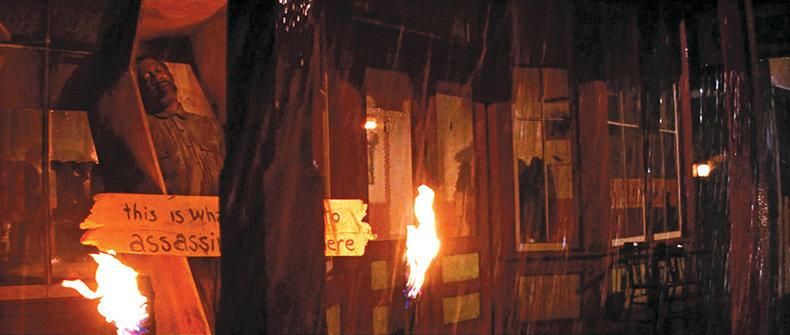
Here we don't see William Munny's reaction at all but we're tracking in his point of view as he finds his friend's body (Morgan Freeman) exhibited on the side of the saloon—they used to do that in the West as a warning, with this morbid sense of humor. We shot Munny's frontside but in the editing room we thought it was really interesting. It was kind of cool and haunting. We knew we were going to see a lot of Munny in the next sequence. Why not save it up? It was more impactful this way. This is a set we built in Alberta, Canada. The governor loaned us his helicopter to scout and we found this ranch. So we flew down and knocked on the door, and the guy said, "No problem." So, we built the town right there.
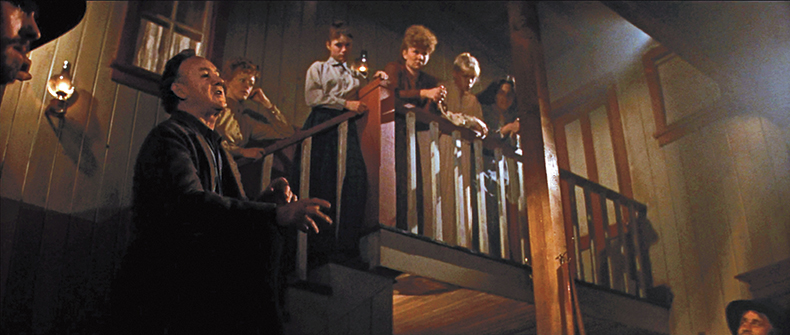
Inside, everyone's having a good time with the sheriff, Little Bill (Gene Hackman), buying drinks and planning a search party. What was brilliant about the screenplay was its gradual build to Munny's confrontation with Bill. Little Bill is a charming guy who just wants to keep order. But when he snaps, he goes for really heavy violence. It made for a very interesting character. Gene originally didn't want the part. He was just getting ready to retire and didn't want to do any violence because of some of the movies he'd done in the past. So, I had to talk him into it.
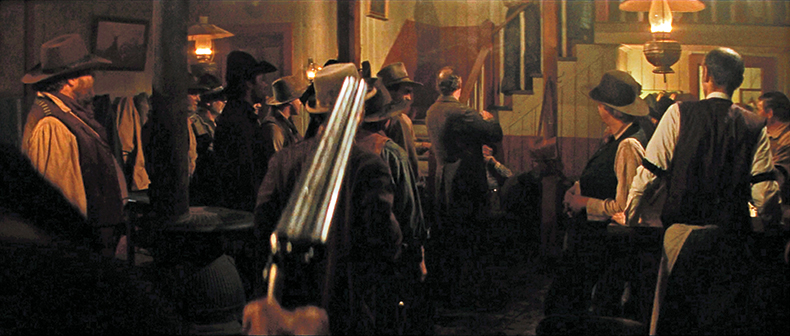
Next, out of nowhere, Munny's shotgun rises into frame, and he's pissed. I don't remember whether it was planned because I find so much in the moment to accentuate here and there, but the shotgun's appearance is dynamic. I like to shoot rehearsal because I don't want to overthink it and rehearse too much. I love to see what happens the first time something has crossed an actor's brain, without worrying about technical stuff and hitting his marks. So I don't intellectualize it unless something really needs explaining. The actors know their roles, the script, they're smart; so, I'll explain the moment and tell them what the shot's going to do and the effect the camera is supposed to have, so everyone's fully aware.
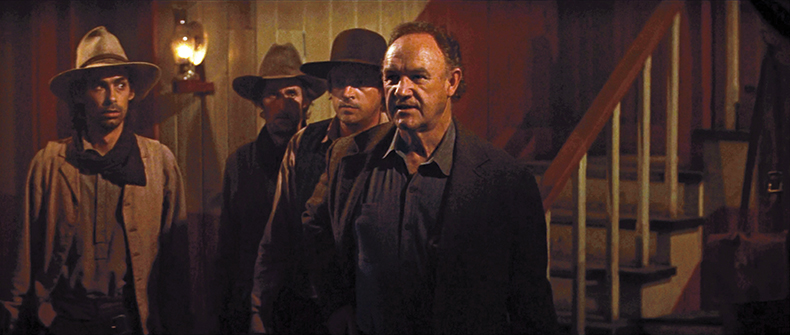
Munny shoots the saloon owner and turns on Bill. The art direction, the lighting, it's all meant to feel natural and authentic for a time when there was no electricity. We built the town so we put in the lights our cinematographer, Jack Green, wanted. In some Westerns, it looks all lit up like it's downtown. Here, there's not that much lighting in the room except kerosene lamps because that's what would have been there and that's what this picture wanted—it's not a satire. It was meant to discuss violence in an open way. I loved Westerns when I was a kid, and did the ones I did in Italy—which were definitely operatic and a fun style—but I never saw one I really thought was real.
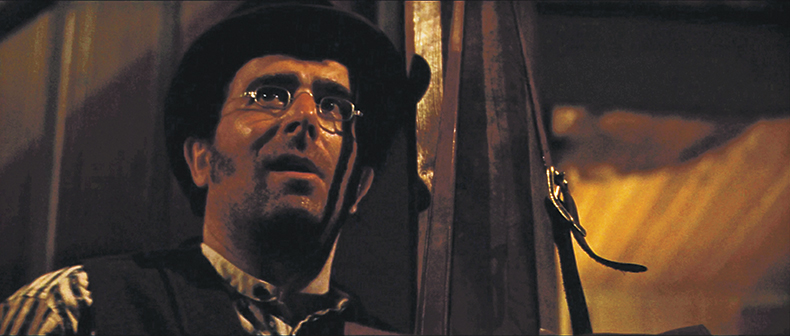
The scene is seen through the reaction of the journalist (Saul Rubinek). He's been chronicling this Wild West stuff. But all of a sudden, he's in the middle of it and he's not sure he likes it. We shot on Technicolor lenses; this is probably a 100mm, four-inch lens that could go in close like this and be less apt to distort. Most of the time, I shoot single camera, to give the shot my full attention. You're trying to make it look as real as possible, so it doesn't distract from the emotions of the scene.
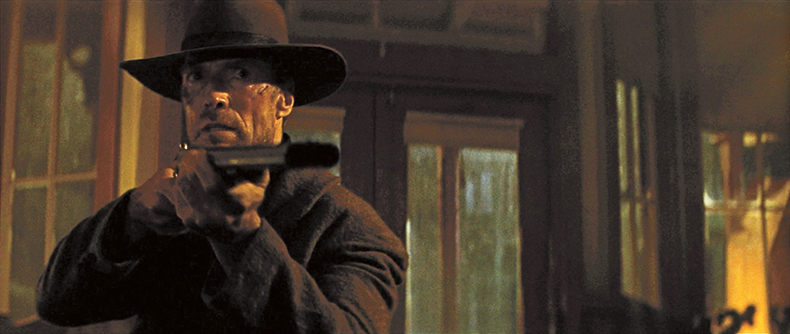
Here we push in on Munny as he is about to shoot Bill, which accentuates the thought for the audience: "Is he or is he not? What's he thinking?" Rather than just have him go, "Bam!" you stretch it out a little bit and give the audience a chance to revel in it. We kept Munny to the left of the frame because the set was a character, too. I wanted to see the salon, where he was, what it had all come to. We shot 35mm, Panavision CinemaScope. When you're out in the prairie, it gives you much more width.
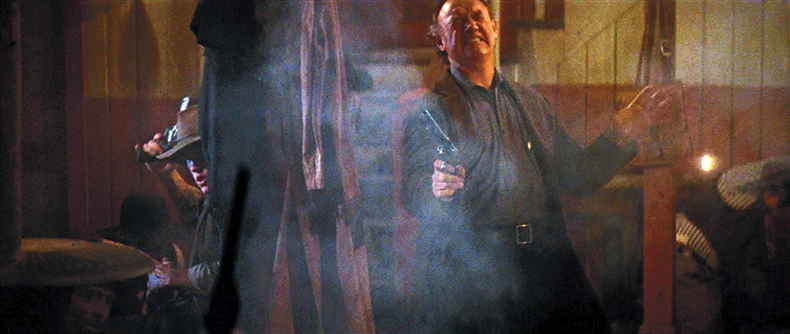
Munny's shotgun misfires and it turns into sheer mayhem from there. Acting is an emotional sport, not an intellectual one. If actors start thinking about it too much, they can talk themselves out of it. Acting also takes concentration, so my sets are really quiet. There's nobody's yelling, "Action!" I just say, "Okay, now go," so they can slide right into it without getting their heartbeats up to the point where it's higher than the emotions of the scene. Unforgiven was a unique script. Everything just jumped off the page visually. You read it, you saw it. Everyone probably wanted more dialogue, but the script was perfect. During this scene, the dialogue was minimal. It was all about internal emotions.
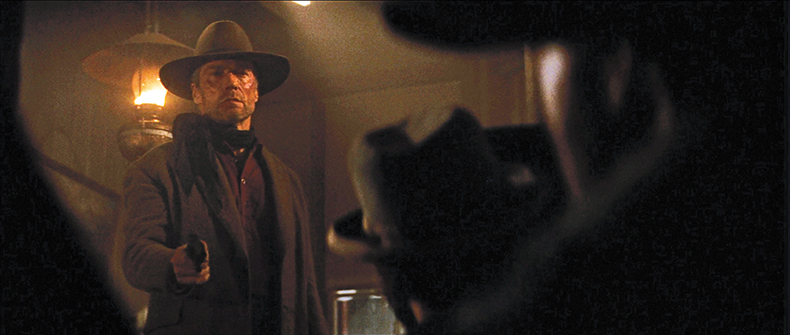
Munny's telling the guy in the right foreground to get out of there. By keeping the guy in frame, you keep them tied together. Then, when I turn around to get his reaction shot, the audience understands the geography as it's happening and nothing shocks them inadvertently to throw them out of the scene. The kerosene lamp behind Munny keeps it backlit with cross lighting from his left side. The scene is generally backlit by the light that's hanging there, so it all seems to look normal when of course, there are studio lights to supplement.
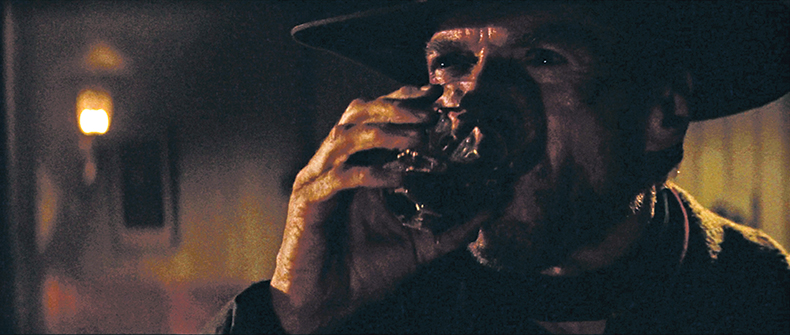
Munny steps up and pours himself a shot. This is the moment he's gone back to being the old renegade killer that he was. I love shadow. If you photograph somebody's face offset, maybe see one eye and part of another, you get something that's more dynamic. What I like in a film is what your imagination is seeing, as opposed to your eyes. If they don't quite see, the audience wonders, "What's going to happen now? Is he going to be shot in the back?" Jack Green and I were brought up with Bruce Surtees, who would light stuff with a penlight just to get a little effect—Bruce and I were always very much in sync and Jack had the same instincts.
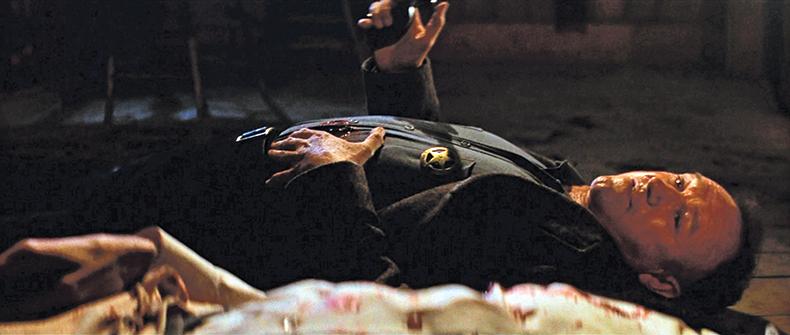
Dangerous to the end, Bill is still alive, reaching for his pistol, and we cut between him and Munny. Sometimes I'll shoot things only the way they're supposed to be edited, and not give it any other coverage. But in scenes like this, where Munny is cleaning house, I give myself and the editor a chance to make choices later on as to how long each shot holds on one person or the other. Joel Cox was the editor on this one. He'd argue for what he did and, between us and the assistant editor, everybody got on the same page.
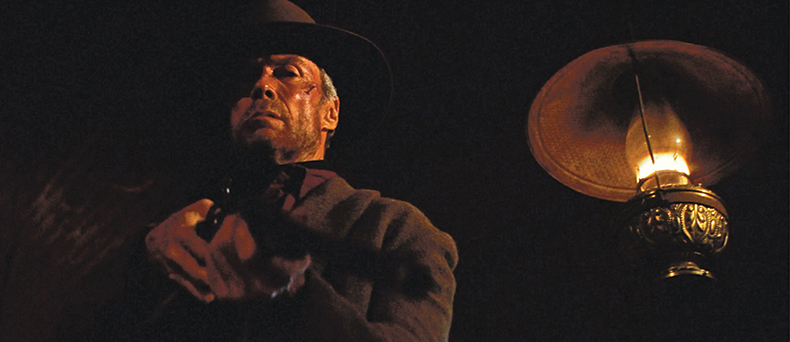
When Munny turns around and sees Little Bill on the floor, you know he's going to kill him, and the audience is probably rooting for it by now. Munny has the kerosene lamp on his face and we'd have a movie light higher, augmenting, but that would be it. Making those decisions, you can always ask, "What's the most realistic thing?" Well, there were lights in the middle of the room, and everybody can be photographed accordingly. But the main thing is, what are you going to succumb to? That technical aspect? Or the fact that you want this picture to look really good, and the scene to be dramatic?
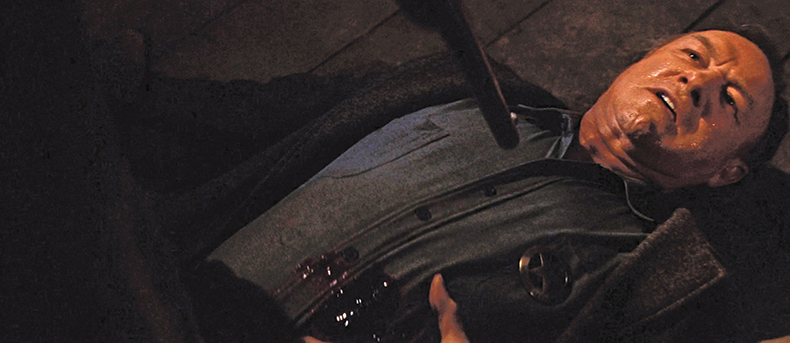
Munny is standing over Bill—we have him sort of cross, backlit. They have an exchange; Munny brings the shotgun up and the rest is history. I expected a lot from Gene and he gave it to me. Making a movie is a lot of little pieces. You have to get a visual of it and keep it with you all the time, then make sure everything you're doing fits in with it. And then, one day you're done and thinking, "What the hell was this all about?" You've looked at it so many times, you're sick of it. And then you show it to somebody and they say, "Hey! This is OK!"
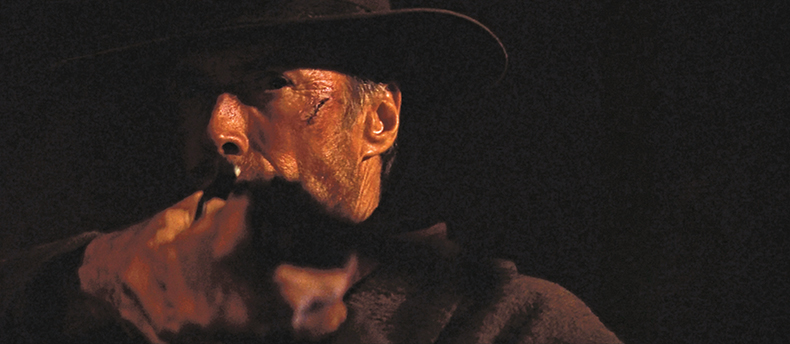
We cut into Munny in close-up and we let everybody savor the fact that he's going to take Bill out. The close-up is just that one suspenseful thing before the boom! There are a lot of different ways you could film this shootout, but I go with what feels right at the moment. You have to let your mind go and not be afraid to accept things as they're unraveling, and to spot them as they're unraveling. It's not an intellectual art form, especially under the gun like we were, needing to shoot two days of footage in one. It's much more improvisational.
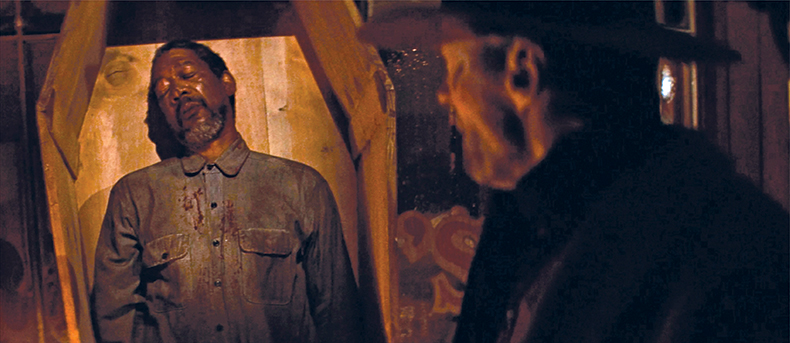
We track, angled up at Munny in profile, coming back outside and taking a last look at his pal, racking focus between them. As a rule, I don't rack focus because I think it's distracting, but this was a quick shot and to make a cut seemed unnecessary. The emotion is understated in some ways, and it's bigger than life in others. When you start shooting, you have to stay true to what your first impression was, because if you start overthinking it, you can change your attitude nine different ways, and pretty soon you have nothing. That's why I try to shoot emotionally rather than intellectually—I don't want to talk myself out of it instead of into it.